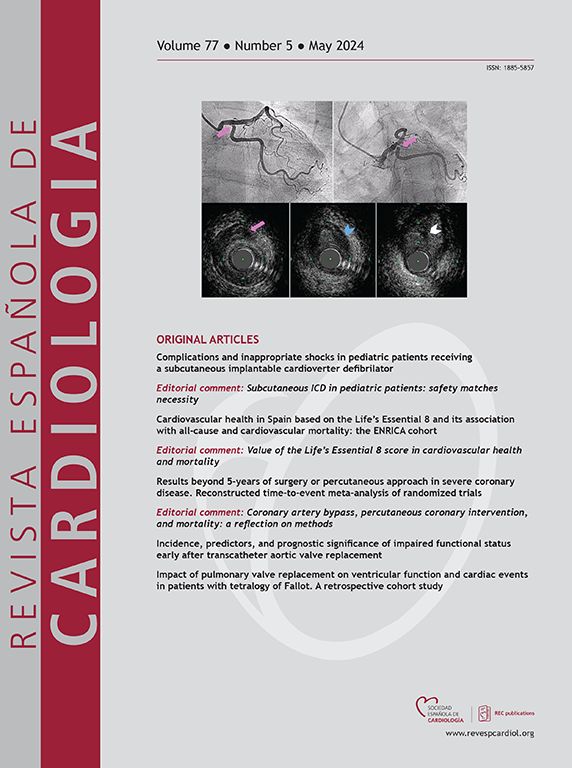植入心脏装置患者三足功能不全的边缘到边缘经皮修复的有效性:TRI-SPA注册结果
IF 5.9
2区 医学
Q2 Medicine
引用次数: 0
摘要
本研究旨在评估三尖瓣经导管边缘到边缘修复(T-TEER)在心脏植入式电子装置(cied)患者中的有效性和临床结果。方法:对西班牙经导管三尖瓣修复(TRI-SPA)登记的患者进行亚分析,包括2020年6月至2023年5月在西班牙接受T-TEER治疗的至少严重三尖瓣反流(TR)患者。没有或轻度三尖瓣铅-小叶相互作用的cied患者与没有cied的患者进行比较。主要综合终点为全因死亡率、心力衰竭相关住院和12个月时三尖瓣再干预。结果在接受T-TEER治疗的310例明显TR患者中(平均年龄75.5±9.1岁,70%为女性),35例(11%)发生cied。两组植入术成功率均较高(CIED组为97.1%,非CIED组为96.4%,P = 0.81),残余TR≤2+的比例相似(CIED组为84.9%,非CIED组为91.0%,P = 0.26)。cied患者的主要综合终点率与非cied组相当(分别为23.8% vs 19.1%, HR为1.40;95%CI为0.60-3.31;P = 0.44),持续成功的TR降低(55.0% vs 73.8%, P = 0.07)和功能改善(NYHA I/II类81.8% vs 79.9%, P = 0.79)。结论:在现实环境中,T-TEER似乎是中度以上TR和cied患者的有效治疗选择,没有或轻微的铅叶相互作用,与没有铅叶的患者相比,T-TEER提供了相当的心血管结局和临床改善。然而,cied的存在可能是TR复发的独立危险因素。本文章由计算机程序翻译,如有差异,请以英文原文为准。
Eficacia de la reparación percutánea de borde a borde para la insuficiencia tricuspídea en pacientes portadores de dispositivos cardiacos implantables: resultados del registro TRI-SPA
Introduction and objectives
This study aimed to assess the effectiveness and clinical outcomes of tricuspid transcatheter edge-to-edge repair (T-TEER) in patients with cardiac implantable electronic devices (CIEDs).
Methods
This subanalysis of the Transcatheter Tricuspid Valve Repair in Spain (TRI-SPA) registry included patients with at least severe tricuspid regurgitation (TR) who were treated with T-TEER between June 2020 and May 2023 in Spain. Patients with CIEDs and no or mild tricuspid lead-leaflet interaction were compared with those without CIEDs. The primary composite endpoint was all-cause mortality, heart failure-related hospitalization, and tricuspid valve reintervention at 12 months.
Results
Among 310 patients (mean age 75.5 ± 9.1 years, 70% female) with significant TR treated with T-TEER, 35 (11%) had CIEDs. Device implantation success was high in both groups (97.1% in the CIED group vs 96.4% in the non-CIED group, P = .81), with a similar rate of ≤ 2+ residual TR (84.9% in the CIED group vs 91.0% in the non-CIED group, P = .26). Patients with CIEDs experienced comparable rates of the primary composite endpoint to the non-CIED group (23.8% vs 19.1%, respectively, HR, 1.40; 95%CI, 0.60-3.31; P = .44), sustained successful TR reduction (≤ 2+ in 55.0% vs 73.8%, P = .07), and functional improvement (NYHA class I/II 81.8% vs 79.9%, P = .79).
Conclusions
In a real-world setting, T-TEER seems to be an effective therapeutic option for selected patients with more than moderate TR and CIEDs with no or mild lead-leaflet interaction, offering comparable cardiovascular outcomes and clinical improvement to those without leads. However, the presence of CIEDs may represent an independent risk factor for TR recurrence.
求助全文
通过发布文献求助,成功后即可免费获取论文全文。
去求助
来源期刊

Revista espanola de cardiologia
医学-心血管系统
CiteScore
4.20
自引率
13.60%
发文量
257
审稿时长
28 days
期刊介绍:
Revista Española de Cardiología, Revista bilingüe científica internacional, dedicada a las enfermedades cardiovasculares, es la publicación oficial de la Sociedad Española de Cardiología.
 求助内容:
求助内容: 应助结果提醒方式:
应助结果提醒方式:


